Evaluation of grain legume cropping systems for animal fodder potential and impacts on subsequent wheat yield under less favourable soil conditions in organic agriculture in Luxembourg
Keywords:
Grain legume, previous crop, unfavorable soil conditions, organic agriculture, LegoLux, CobraAbstract
Grain legumes are important crops required for protein-rich animal fodder. The aim of this study was to (i) examine the suitability of grain legume cropping systems for cultivation as protein-rich fodder, (ii) compare the performance of winter and spring types of faba beans and peas, as well as to compare the performance of peas sown in pure stand and in mixture with cereals, and (iii) determine the impact of previous legume crop on succeeding wheat under less favorable soil conditions in organic agriculture. In a field trial on a commercial farm in Luxembourg, eight grain legume cropping systems (as given under ii plus soybean and blue lupin) and a non-nitrogen fixing control crop (triticale) were cultivated followed by wheat in two consecutive seasons, employing a randomized complete block design with four replicates. All cropping systems except for winter pea in pure stand, were suitable for cultivation as protein-rich fodder even under less favourable soil conditions. Given sufficient soil moisture, faba beans constituted the best choice (protein yield: 961–1193 kg ha–1). Semi-leafless peas reached a significantly better yield when sown in pure stand (p ≤ 0.05; 3539–4154 kg ha–1) compared with the mixture (2920–3852 kg ha–1), whereas full-leaf types should be cultivated with a cereal partner. Winter vs. spring faba beans did not perform significantly different while for peas, the spring form performed best, likely again depending on leaf type rather than sowing time. The lower previous crop value of mono-cropped cereals (yield first experimental sequence: 2056 kg ha–1) compared with cereals in mixture with grain legumes was confirmed, with best performance of wheat succeeding spring pea in pure stand (first experimental sequence, yield: 3661 kg ha–1). Grain legumes in pure stand exhibited a higher previous crop value than winter triticale or grain legumes grown in mixture. In conclusion, grain legumes were promising candidates for generating protein-rich feedingstuffs, even under less favorable soil conditions in organic agriculture in Luxembourg.
DOI: 10.5073/JfK.2016.06.02, https://doi.org/10.5073/JfK.2016.06.02
Published
Issue
Section
License
The content of the journal is licensed under the Creative Commons Attribution 4.0 License. Any user is free to share and adapt (remix, transform, build upon) the content as long as the original publication is attributed (authors, title, year, journal, issue, pages).
The copyright of the published work remains with the authors. The authors grant the Journal of Cultivated Plants, the Julius Kühn-Institut and the OpenAgrar repository the non-exclusive right to distribute and exploit the work.







